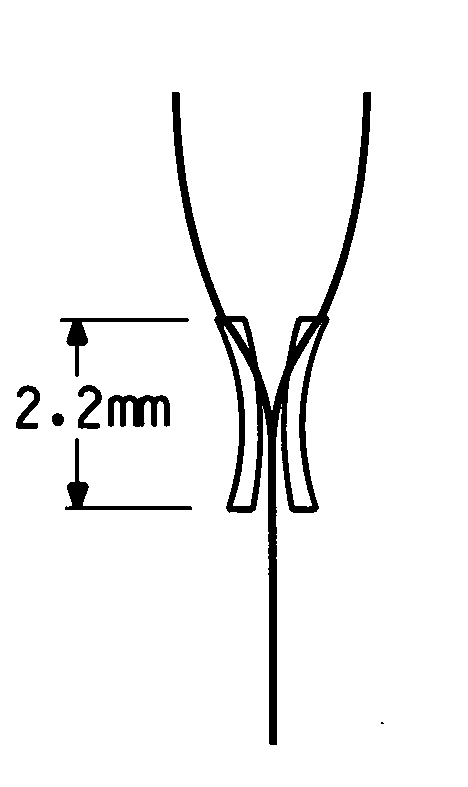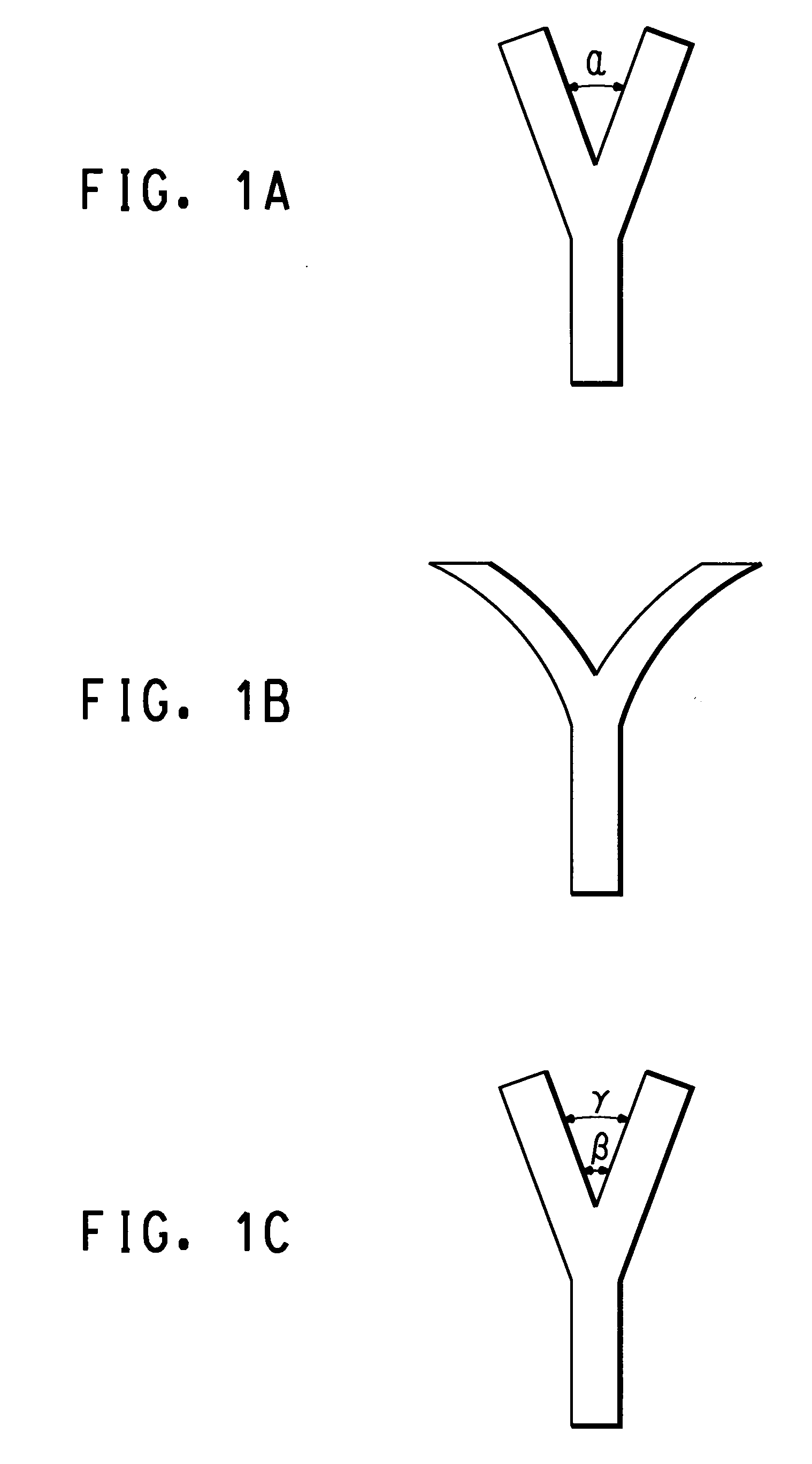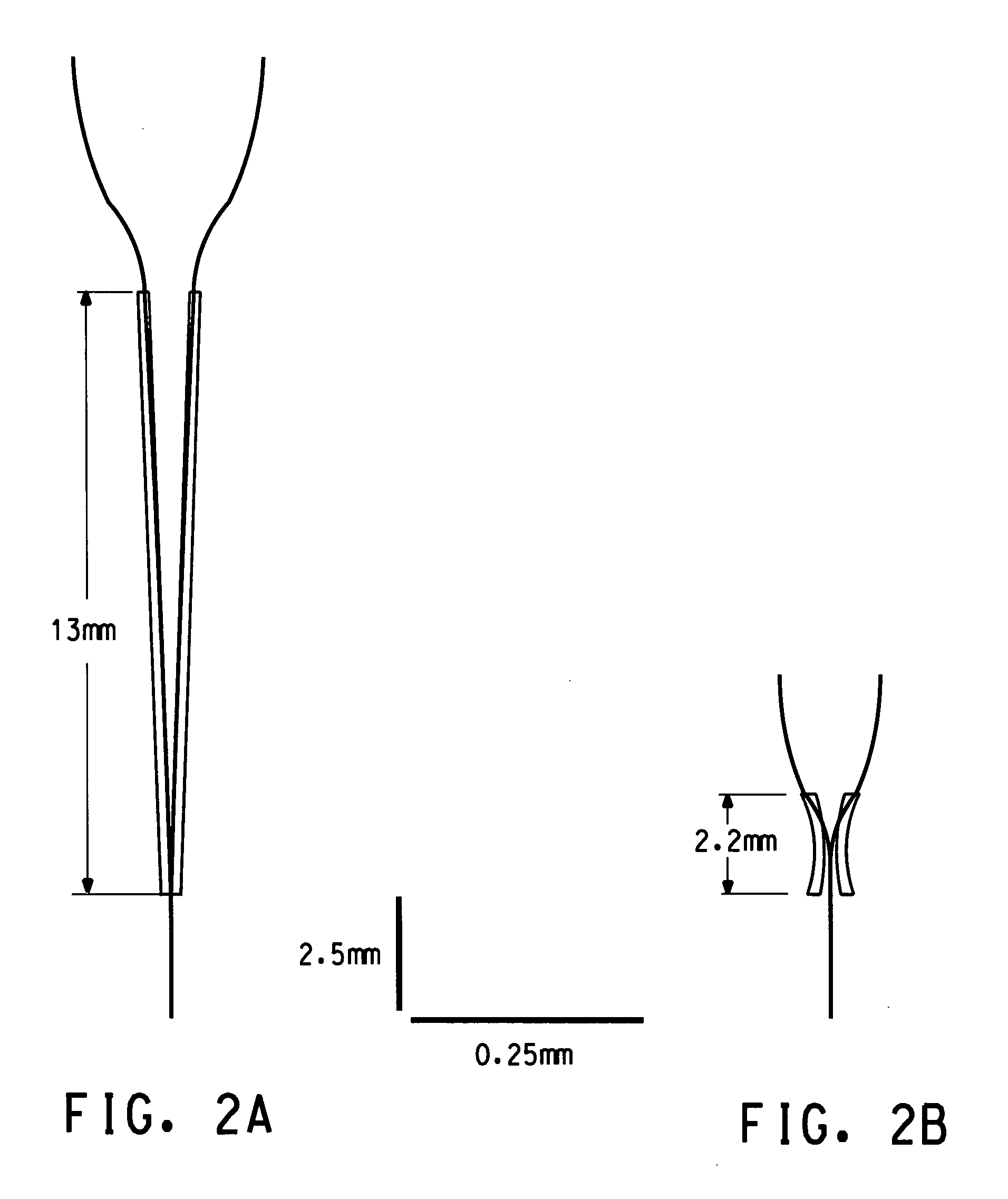[0036] A further benefit of the present invention is that because the heated length can be shorter, the vertex angle can be as large as 10-15°, ca. 10 times the angles taught in the art.
Actual practice in fabricating Y-branches according to the teachings of the art normally results in the creation of un-etched material at the vertex, which greatly aggravates PDL in the propagated
signal. As emphasized in Mossburger et al, op.cit., having a “perfect” vertex is critical to performance. With the larger vertex angles of the present invention, it is much easier to achieve sharp definition of the vertex and control of the shape with concomitant reduction in PDL.
[0037] One particularly surprising aspect of the present invention is that contrary to the teachings of Moosburger, a blunted vertex such as that depicted in FIG. 1c can result in reduced PDL with no significant light loss.
[0038] One of skill in the art will appreciate that the heating profile of choice will depend upon many factors including the specific choice of materials from which the
waveguide is fabricated, the architecture of the
waveguide, whether or not there is an intervening layer of cladding between heater and core, the
wavelength of the propagating
signal, the
rapidity of switching desired, whether or not it is desired to employ the device partly or exclusively as a variable
optical attenuator, and so forth.
[0039] It is desirable in the practice of the invention that the heating profile be a smoothly varying function of position on the surface of the
waveguide being heated. Sharp discontinuities in
heat flux must be avoided in order to avoid sudden changes in
refractive index in the waveguide, which can result in
mode matching losses.
[0040] In the practice of the present invention it has been found that power levels of 10 to 50 mW are effective in causing switching in polymers characterized by dn / dT in the range of −2 to −5×10−4 / ° C. Examples of such polymers include but are not limited to polyacrylates, polyfluoroacrylates, and polychloroacrylates. Power levels of 30-150 mW are found to be effective with polymers characterized by dn / dT of −0.5 to less than −2×10−4 / ° C. in absolute value. Examples of such polymers include but are not limited to
polycarbonate and polymethylmethacrylate. In a typical embodiment of the present invention, the entire waveguide is made from the same polymeric
system.
[0041] In the practice of the present invention, temperature increases in the core may range from 10 to 100° C. The high temperatures are generally narrowly localized, and are beneficially achieved by use of a heater having a relatively narrow “neck” area. As will be understood by one of skill in the art, resistance in a metallic conductor increases inversely with cross-sectional area. Thus for a given power input to the heater, the localized heating in the narrow cross-section will be highest.
[0042] The present invention is operable with any convenient heating means such as is known in the art. This can include
induction heating,
radiative heating, and electrical resistive heating. From the standpoint of simplicity of implementation, electrical resistive heating is preferred. Electrical resistive heating may be accomplished according to means wellknown in the art. In one approach, a
thin metal strip is sputter coated onto the waveguide using a
mask to prepare the heater shape desired. When the heater is not disposed on the surface of the output branch over its entire length, it is deposited on top of that part of the overclad on the
chip where there is no core underneath.
[0044] Suitable metals for electrical resistive heating according to the present invention include but are not limited to
chromium,
titanium, aluminum,
nickel, gold,
platinum. Preferred are
chromium,
titanium,
nickel, and gold. The spatially non-uniform heating according to the present invention may be accomplished by applying a thin film heating strip of variable cross-sectional area onto the waveguide surface at any convenient location thereupon
[0045] The present invention places no specific limits on the manner in which spatially non-uniform heating may be accomplished. In one embodiment of the present invention, spatially non-uniform heating is beneficially accomplished by employing a heating means of
uniform design which is disposed with respect to the waveguide in a manner which results in the imposition of a non-uniform
heat flux onto the waveguide surface. Illustrative of this embodiment are the configurations shown in FIGS. 4. One of skill in the art will appreciate that many other embodiments of the same generic nature. Such embodiments include but are not limited to rectangular heaters with curved waveguides, rectangular heaters with straight waveguides, curved heaters with straight waveguides, and curved or rectangular heaters with straight waveguides wherein the vertex of said Y-branch is blunted.
[0046]FIG. 4 depicts an embodiment of the invention wherein the output waveguide is curved, the heater is uniform in design, and the heat-flux delivered to the waveguide surface is a smoothly continuous function of the proximity of the heater to the waveguide surface. In this case, the greatest amount of heating occurs at the point farthest from the vertex. Two slightly different embodiments are depicted, differing by the slightly different shapes of the heaters.
[0047] One of skill in the art will appreciate that any of the Y-branch designs depicted in FIGS. 1a-1c, and the others as described hereinabove, can be substituted for the Y-branch depicted in FIGS. 4a and 4b with no loss of effectiveness in the practice of the present invention.
[0048] In a preferred embodiment of the present invention, a heater wherein the cross-sectional area thereof is not constant is disposed along the length of the output waveguides. In this embodiment, a non-uniform
heat flux is imposed upon the waveguide surface by virtue of the higher temperatures realized in the portions of the heater having smaller cross-sectional areas. In a more preferred embodiment, the heater is in the shape of a bow-tie wherein a rectangular portion gives way at each end in the longer dimension to a triangular portion, the two triangular portions being joined at their truncated apexes. In this embodiment, the heat flux incident upon the surface of the waveguide increases continuously along the long dimension of the heater as the cross-sectional area narrows until it reaches a peak at the narrowest point, and then continuously decreases with increasing distance from the narrowest point along the long dimension of the waveguide. In the most preferred embodiment hereof, the narrowest portion of the heater is disposed in close proximity to the vertex, thereby subjecting the region of the vertex to the highest temperature. Because of the continuous nature of the effect herein realized, one of skill in the art will understand that a small positional deviation of the narrowest point on the heater from the
closest point of approach to the vertex will have little effect on the practive of the present invention.
[0049] The most preferred embodiment is depicted in FIGS. 5a and 5b wherein two slightly different bow-tie designs are placed along the straight output waveguides wherein the Y-branch depicted is that in FIG. 1c wherein the angle β is 0.2-4.0° preferably 0.4-1.0°.
[0051] One of skill in the art will further appreciate that the requisite heating profile of the invention may be obtained by employing a plurality of individually uniform heaters along the length of the output branch, at least two of said heaters being heated to different temperatures. This embodiment is however less preferred because of the multiplicity of wires and controllers which would be required for its implementation.
[0051] One of skill in the art will further appreciate that the requisite heating profile of the invention may be obtained by employing a plurality of individually uniform heaters along the length of the output branch, at least two of said heaters being heated to different temperatures. This embodiment is however less preferred because of the multiplicity of wires and controllers which would be required for its implementation.
[0052] Placement of the heaters according to the present invention may have a significant
impact on the
operability of the present invention. If a heater is positioned on the top surface of an output branch, it will be in very close proximity to the other output branch, and it is highly likely that some undesirable degree of heating will occur in that output branch which is not intended to be heated. For this reason it is highly desirable that the heat flux from the heaters be directed to the outside edge of the respective branches in order to place as much as possible of the thermally insulating waveguide between the heated surface and the adjacent waveguide. Thus
lateral positioning of the heater is an important consideration.
[0053] The Y-branch of the invention may be beneficially employed not only as a digital optical spatial switch but as a variable
optical attenuator (VOA). This is accomplished by heating the output branches to temperatures below the
threshold temperature for switching. In the operation of the VOA according to the present invention, the degree of transfer of power from one branch to the other is continuously varied by continuously varying the heat input until the stage at which essentially all the
optical power is transferred to one output waveguide, after which further heating has no effect—the
digital switching region. When the Y-branch is operated as a VOA, a first arm is heated to achieve attenuation up to 3 dB or 50% (in
polymer, said first arm is not the output arm), and the second arm is heated to achieve attenuation above 3 dB (in
polymer, said second arm is the output arm). The heat may then be subject to small adjustments to alter the
relative intensity of propagation in the two branches.
 Login to View More
Login to View More 


